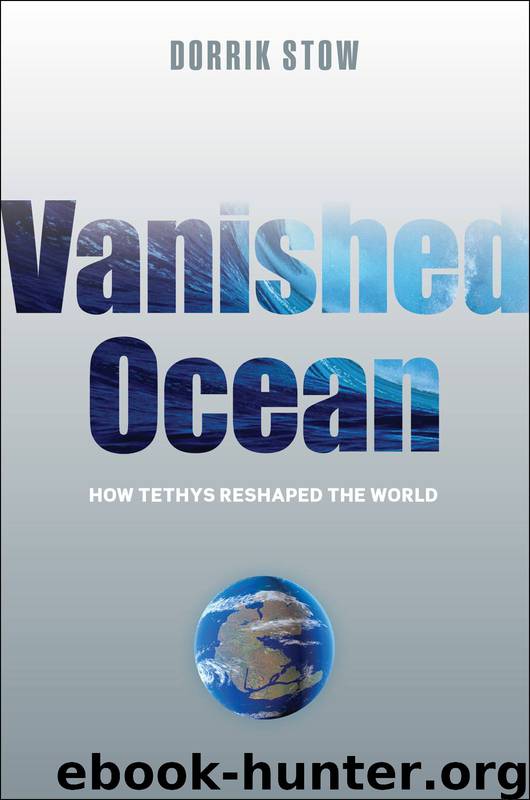Vanished Ocean by Dorrik Stow

Author:Dorrik Stow [Stow, Dorrik]
Language: eng
Format: epub
Publisher: Oxford University Press
Published: 2010-05-27T00:00:00+00:00
RISE AND FALL OF SEA LEVEL
At this stage in the history of Tethys, therefore, a huge mid-ocean ridge ran as a jagged submarine mountain belt, somewhere hidden from view along the equatorial region between the continents of Laurasia to the north and Gondwana to the south. This had developed along the axis of one or more of the rifts that originally split Pangaea in two. Mantle hot spots would doubtless have existed, both on and off the ridge itself, perhaps giving rise to islands and archipelagos such as St Helena and the Azores today. To avoid any confusion, I should reiterate here that not all hot spots lie along mid-ocean ridges. Those that were implicated in the rifting and break-up of Pangaea lay beneath a continent; the Hawaiian hot spot in the Pacific Ocean today lies very far from the Mid-Pacific Ridge.
One of the other rifts that originally formed as Pangaea broke apart also began to spread about an incipient ocean ridge, first opening up as a narrow arm of the Tethys, but later evolving into an ocean in its own right – the South Atlantic. Indeed, our drilling on DSDP Leg 75 had shown ocean spreading from just over 100 million years ago and, not long after that, a further burst of volcanic activity (probably hot-spot related) along an ancestral Walvis Ridge. That this gave rise to seamounts and coral-rimmed islands, we know from evidence of their existence in the sediment record we cored. In addition, further to the east, India had rifted from the southern part of Gondwana and what was later to become the Indian Ocean had begun to form.
As I have mentioned before, this period – the late Cretaceous – was a time of extremely high sea level across the world. Although it is difficult to be precise about just how high the sea rose, we are confident that it was at least 200 metres higher than that of today and our best estimates place it at closer to 300 metres higher. In imperial measurements that is 1000 feet of water towering above our heads! About half the area occupied by the continents today would have been submerged – a meagre 18% remaining, most as a low-lying, green and fertile land of islands and small continents. It was these balmy shores against which Tethys’ waters lapped. But, before I turn to the marine life that had evolved to populate those seas, I should explain a little more about this whole question of sea level. As we shall see, there is a close link between active sea-floor spreading and the height of sea level globally.
As a young boy growing up in South Devon, I was always fascinated by the tides, especially where there was a broad beach that shoaled gently so that we could body-surf in the waves. Twice daily the sea raced in across the wet rippled sands, and then out again, never once failing – but why did this happen? What forced the tides to
Download
This site does not store any files on its server. We only index and link to content provided by other sites. Please contact the content providers to delete copyright contents if any and email us, we'll remove relevant links or contents immediately.
The Lonely City by Olivia Laing(4731)
Animal Frequency by Melissa Alvarez(4382)
All Creatures Great and Small by James Herriot(4213)
Walking by Henry David Thoreau(3879)
Exit West by Mohsin Hamid(3765)
Origin Story: A Big History of Everything by David Christian(3632)
COSMOS by Carl Sagan(3539)
How to Read Water: Clues and Patterns from Puddles to the Sea (Natural Navigation) by Tristan Gooley(3386)
Hedgerow by John Wright(3260)
The Inner Life of Animals by Peter Wohlleben(3246)
How to Read Nature by Tristan Gooley(3232)
How to Do Nothing by Jenny Odell(3220)
Project Animal Farm: An Accidental Journey into the Secret World of Farming and the Truth About Our Food by Sonia Faruqi(3163)
Origin Story by David Christian(3133)
Water by Ian Miller(3112)
A Forest Journey by John Perlin(3018)
The Plant Messiah by Carlos Magdalena(2868)
A Wilder Time by William E. Glassley(2805)
Forests: A Very Short Introduction by Jaboury Ghazoul(2777)
